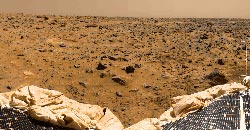|
 |
|
Subsection of a 360 degree panorama taken by the Imager for Mars Pathfinder (IMP). |
Imagine designing a vehicle that could land anywhere in the United States. From beaches and prairies to hills and mountains, the terrain and conditions would be so diverse that the vehicle would have to handle as much variety as possible. That variety is also present on Mars. Without orbiters like Odyssey and the Mars Global Surveyor to take pictures of Mars' terrain, engineers and scientists would have little to go on.
"Pathfinder was the first mission to accurately predict what the landing site was going to be like before getting down to the surface of the planet," Golombek said. However, engineers did not know what conditions the Pathfinder rover would encounter on Mars before they designed the vehicle to survive at least a week of safe roving.
"It's kind of like the chicken-and-the-egg problem," Manning said. "We are trying to learn about what Mars is like by sending missions there, but the missions need to know what Mars is like to go there."
Manning likened the evolution of design for Mars spacecraft to that of bicycles in the late 1800s. "There was a lot of variety back then because they hadn't figured it out yet. Bicycles today look very different than they did back then because we continued to develop them. Vehicles of the future are going to look very different than they do today because we often have to discover what we build as we build it. It's a race between what we learn about the technologies we develop and what we learn about Mars."
Since Pathfinder, engineers have added more intelligence to the spacecraft and more control as the vehicle approaches landing. They have also obtained a better simulation of how winds develop and flow on Mars, as well as a better understanding for how those winds affect a safe landing. This benefits them when picking a landing site, but it limits where and how high they can go.
Sharing the Goods
Since no orbiters operated around Mars during the Pathfinder mission, Pathfinder was unable to transmit information via orbiter back to Earth. Instead, the Sojourner rover used the Pathfinder lander as a middleman to communicate with Earth. This meant that the rover had to stay close to the lander at all times. Unfortunately, this presented limitations not only in the amount of ground scientists could explore, but also in the amount of information they could receive in one day. Sending and receiving information through the lander's direct-to-Earth link (an antenna pointed toward Earth) used up a lot of energy, and the rover's battery had to be saved to keep warm in Mars temperatures, which varied by more than 38 degrees Celsius (100 degrees Fahrenheit) per Mars day.
Scientists and engineers have learned from this, and as a result, have given the Mars Exploration Rover the ability to communicate directly with Earth. The disadvantage here is that images of the rover from the lander will be unavailable; however, the Mars Exploration Rover will have more ways to send information back to Earth. Critical data like spacecraft health and basic information on findings can travel through a direct-to-Earth link like the one used on Pathfinder. Extraneous images and other non-critical data can travel through the close-by Odyssey orbiter, which transmits information to Earth in a matter of minutes.
|